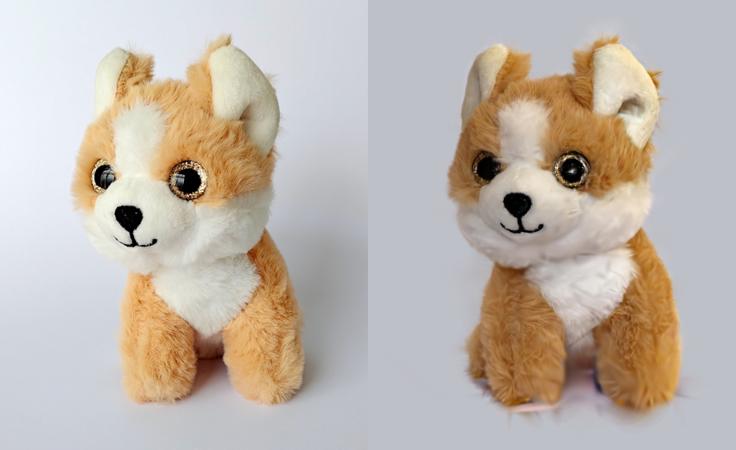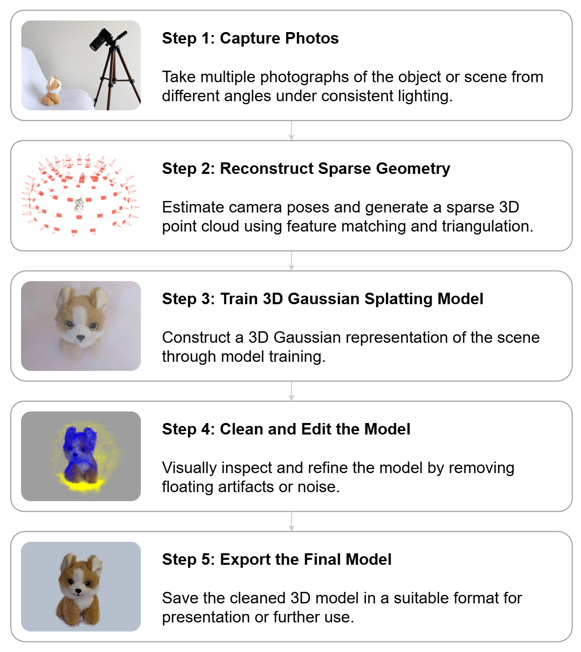From Real Object to 3D Gaussian Splatting Model Using Open-Source Tools
Author: Oleg Boev

Real-world plush toy (left) and its reconstructed 3D Gaussian Splatting model (right).
Introduction
This tutorial explains how to reconstruct a 3D scene from real-world photographs using Gaussian Splatting. The method was introduced in the paper 3D Gaussian Splatting for Real-Time Radiance Field Rendering (Kerbl et al., 2023).
Gaussian Splatting is a modern technique for novel view synthesis. It reconstructs scenes by placing thousands of small 3D Gaussians in space and optimizing their appearance to match the input images. This approach is particularly effective at capturing fine and soft details, such as fur or fabric textures, which are often difficult for traditional surface-based methods.
This tutorial demonstrates the complete pipeline using a real plush toy as the subject. It includes the following steps:
- Capture input images
- Estimate camera poses with COLMAP
- Train the model using gsplat
- Edit and visualize results with SuperSplat
The example shows how to achieve reproducible results using only open-source tools configured for Windows.
This workflow is especially well-suited for scanning physical products or small real-world objects, making it useful for applications such as product visualization, object digitization, and 3D content creation.
About gsplat
This tutorial uses the gsplat repository for 3D Gaussian Splatting. Compared to the original implementation by the authors (graphdeco-inria/gaussian-splatting), gsplat provides several practical advantages:
- Supports faster training, lower memory usage, and large scenes
- Includes features such as multi-GPU support, depth rendering, and anti-aliasing
- Integrates with the Nerfstudio ecosystem for shared tools and pipelines
- Released under the Apache 2.0 license, which allows commercial use
- Actively maintained and used by open-source projects
About COLMAP
COLMAP estimates camera poses and generates a sparse reconstruction from input images. These results are used to train the 3D Gaussian Splatting model. The Windows version of COLMAP includes both a graphical interface and command-line tools.
Note: gsplat is part of the Nerfstudio project, which includes a built-in COLMAP wrapper that runs with default parameters. This is often sufficient, but some datasets require custom settings for successful reconstruction. A later section explains how to adjust key parameters when the defaults do not work.
Note: Other tools such as RealityCapture, Agisoft Metashape, or Autodesk ReCap Pro can be used for similar pipelines. This tutorial focuses on free and reproducible workflows using COLMAP.
About SuperSplat
SuperSplat Editor is an open-source, browser-based tool for viewing, editing, and optimizing 3D Gaussian Splatting models. It supports the following tasks:
- Inspecting results
- Cleaning up artifacts
- Cropping and merging models
- Performing lightweight edits without retraining
SuperSplat can also be installed as a Progressive Web App (PWA) for faster access and desktop integration.
Windows as the target platform
This tutorial focuses on Windows because it is widely used by beginners, students, and general technical users. While many open-source tools are developed for Linux, Windows users often face additional setup challenges due to platform-specific differences.
Questions about installing and running COLMAP and gsplat on Windows are common in forums, GitHub issues, and online communities. This tutorial provides a clear, step-by-step workflow tailored to Windows to help make modern 3D reconstruction techniques more accessible.
Pipeline overview
This tutorial walks through the full pipeline for building a 3D Gaussian Splatting model from real-world images. The process includes four main stages:
- Image capture
- Camera calibration and sparse point cloud reconstruction with COLMAP
- Model training using gsplat
- Final editing and visualization in the SuperSplat viewer

Overview of the 3D Gaussian Splatting pipeline.
The following sections explain each step in detail. You can skip to a specific section if you’re interested only in training, visualization, or another part of the workflow.
© 2025 SmartDataScan.
This section is licensed under a Creative Commons Attribution-NonCommercial-ShareAlike 4.0 International License.